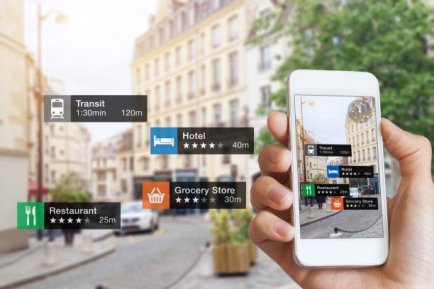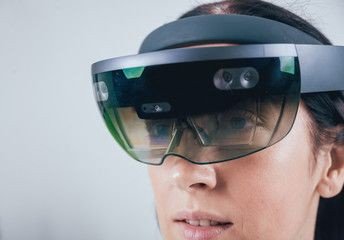2020 has been predicted as a turning point for Augmented Reality. Talking heads have forecasted this to be the breakout year for glasses and headset hardware as well as software. Many events have happened already in 2020 that both enforce and contradict this prediction. So that leaves the question, where are we at with almost half the year gone by?
AR and VR, for the uninitiated, still seems to be confusing and people use these terms interchangeably although there are noticeable differences. Whereas Augmented Reality allows the user to still see parts of their environment and overlays (or augments) of their reality by placing objects into their surroundings, Virtual Reality on the other hand, gives the illusion the user is transporting to a different environment by donning a headset in which they can no longer see their surroundings. Further complicating the distinction is the term Mixed Reality which seems to be fading out in favor of augmented reality. What it all boils down to is, AR lets you see your immediate surroundings while VR does not.
Smart phone Augmented Reality is starting to see some uptick. The AR category in app stores is growing. Apps such as Tik Tok and Snapchat which have AR built into them allowing user to overlay things that don’t really exist into their environment, are starting to train the world on what AR can do at the bare minimum. Apps created to easily measure items in a house with a smart phone, play games that overlay their environment (Pokémon Go) and experience one-off holograms that run, jump or drive around their living rooms are taking hold. As the world adopts to the latest Android and Apple phones, people are being exposed to Google ARCore and Apple’s ARKit framework. This step is necessary for many reasons. First, as mentioned, it gets the world ready for the next level of apps that will be usable on glasses and headsets. Second, developers are practicing their skills building 3D interactive apps with new tools such as Unity and UnReal, the two most popular game development engines. Third, there isn’t much on the market in terms of glasses and headsets yet that consumers are willing to pay for.
Glasses and Headset Augmented Reality are also often used interchangeably but they too have a distinct difference. Headsets are defined as the bigger, bulkier AR devices that usually wrap around the user’s head versus glasses that usually resemble sunglasses or prescription glasses and are much lighter and smaller. The headsets have statistically been created for Enterprise with a higher price point (usually above US$1000) and the glasses more geared towards consumers with a price tag lower than US$1000. There are two ways these devices are being engineered: see-through and pass-through. The see-through devices project holograms onto a clear, usually plastic, overlay in front of the user’s eyes. The pass-through devices use a type of screen and camera mechanism to show the user’s environment on the screen and then overlay holograms onto the screen which makes them appear to be in the user’s environment. The see-through experience is much more engaging and believable where the pass-through has quite a few limitations and is much less believable.
In 2020, the see-through devices are usually seen with the higher-end headsets and the pass-through on the lower end glasses. One major reason for this is computing power. The bigger headsets are able to onboard the computing power directly while the glasses offload the computing power to a phone or computer. 2020 is also starting to produce more of the lower-end glasses targeted towards consumers with price points under $1000. These AR glasses gaining mass adaption will be critical in the long-term success of AR. The most important fact to remember for AR devices is that all the big players in technology have announced or already have a working AR device and they are all betting heavily on this tech for the future. What they and most everyone else is waiting for now is the software to make these devices attractive.
Augmented Reality software is the key. What most experts agree at this point is that no matter how small, engaging or cheap AR devices become, there has to be software available for the devices that user’s feel adds value to their life. This is true for both Enterprise and Consumer customers and will be critical for the long-term success of the technology. Putting on a headset or glasses is a big step for a user where they can currently just click a button on their phone and be plugged into their computing environment. In order for this to easily happen, the software they are going to engage with has to be a magnitude greater with the device versus without the device. “The Killer App” is a commonly used term to describe an app that users want so badly, they will purchase a device in order to get it. So far in 2020, this app does not exist – yet. This is where the focus has to come from in the next couple of years, both for Enterprise and Consumer. While the Enterprise market is getting apps in its space that add value, most of the Consumer software does not outweigh smart phone or computer software in terms of ease of use, wow-factor for 3D or fun/productivity gains.
The future state of AR as mentioned above, will focus on building out software that creates value for the Enterprise and Consumer markets in order for AR to get to the next level. There needs to be a few dozen apps in the various app stores for consumers and their smart phones, not just the few that are out there now. A few consumer-based glasses are starting to make it to market this year such as the Mad Gaze Glow/Glow Plus and the nReal glasses, both with price points under $1000. If those devices can prove there is a market for reasonably inexpensive consumer AR glasses and foster software that runs on them via their app marketplaces, consumers will be asking for these devices by Christmas.
Enterprise users using the higher-end AR headsets need more use cases. Healthcare, education, manufacturing and L & D are already starting to take advantage of the benefits of AR. There is an almost infinite number of use cases left to develop for Enterprise and there are new companies popping up every week promising to be the next big software developer for AR. Determining a leader in this space will require a few years as companies are still trying to feel out which headsets are going to be around and which ones offer the best features. Using that information, they’ll try to turn vision into intuitive software that works well in the 3D world.
By the end of 2020, we should have a much better feel of whether the talking heads were correct about this year as being the swing year for Augmented Reality. We will see consumer AR glasses hit the market and we will be able to gauge demand. We will see more AR glasses being announced with anticipated release dates of 2021 or 2022. We will see which Enterprise headsets make it and which ones do not and we will absolutely see more being introduced.
The new question is, will the remainder of 2020 augment our current reality and produce the killer app? That remains to be seen.







